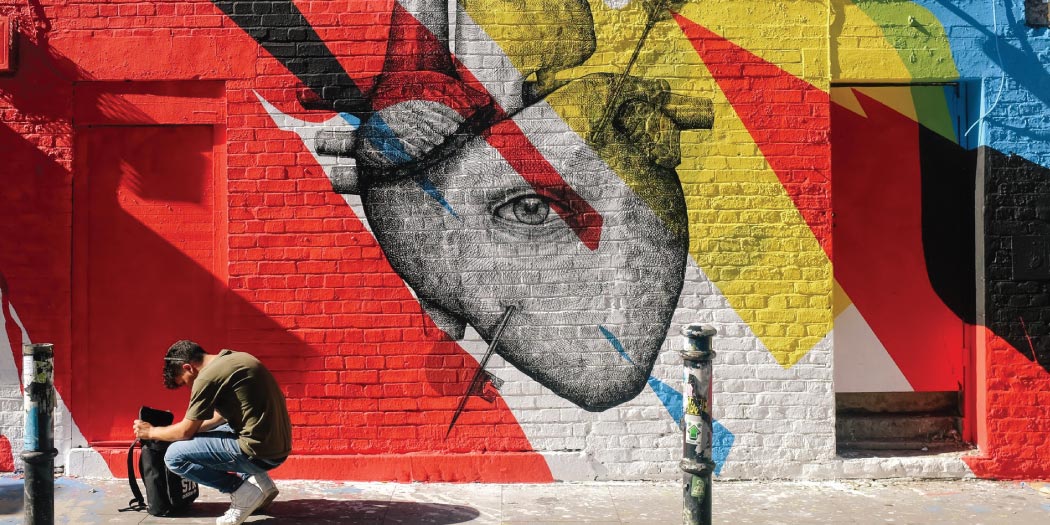
Tap Into Your Creativity
Most of us love to be creative. And it’s probably fair to say that everyone is creative in their own way.
Creativity is also an ingredient to living a life with a greater sense of purpose and passion. You need a lot of creative thinking to make it all work. But some of us may not know how to tap into our creativity, or get out of a block. Or how do we stay inspired? Or maybe you feel tapped out?
We get it. We have those moments too.
We take creativity seriously. We look for examples of it, celebrate it, and practice it as much as possible. We’re on a mission to help our community harness their creativity, discover new ideas and find amazing, innovative people to follow.
In this article, we’ve compiled four ways of utilizing your creative muscles, and a couple inventive people to help spark some ideas.
Expand Your Definition of Creativity
Creativity isn’t just about painting, making music, or novel writing—although all three do indeed require a lot of creative talent. It’s much broader than creating masterpieces. It’s also about finding beauty in the mundane, incorporating creativity into the details of everyday life and even using it to solve problems.
When you expand your understanding, you’ll discover new ways to apply your ideas. This is especially important because it allows you to see past your boundaries, and borrow ideas and inspiration from places and people you wouldn’t normally look to.
Our founder, Christopher Swan has a saying that we love, “Inspiration is everywhere—you just have to look.” TWEET THIS
Someone who inspires us in this way is Paige Smith, AKA A Common Name, a Los Angeles-based artist who creates “Urban Geodes,” a street art series of sculptures that resemble geodes, and are made entirely of paper and resin casts. She tucks her geodes away in the sides of buildings, walls, and abandoned phone booths in her community in the Historical Arts District of Los Angeles.
On her website, Paige says her work is “infused with a magical realism that encourages us to pause, to discover, to be present and to find beauty in the mundane.”
We think Paige is a great example of applying creativity in a way that’s different. This is also a great example of someone to look to for ideas. How could you apply this juxtaposition idea in something you’re creating or trying to solve?
Look for opportunities to expand your definition—and expression—of creativity. Even in the everyday and lower case moments of life.
Try This Formula for Creativity
This man came up with the world’s most famous equation, E=MC2, the formula for mass energy equivalence. But it’s Einstein’s approach to creative thinking that we’re most interested in.
When Einstein would get stuck on a mathematical problem (yes, even Einstein had creative blocks), he would employ the principle of “combinatory play”— which is taking two unrelated things and putting them together to generate new ideas. It’s a strategy that involves opening up one mental channel by dabbling in another.
For Einstein, that meant picking up his violin when he was unable to answer a mathematical equation. During his music break, he’d usually find the mental spark that would help him move forward on the problem at hand.
You don’t have to play an instrument to make this work for you, nor do you need a PhD in physics. If you’re feeling like you’re in a creative rut, follow Einstein’s lead and try combinatory play. Go for a walk, draw, shoot hoops, cook, play mini golf—something to take your mind off of things for a while so you can open up a new mental channel and unlock your creative thinking.
We like to aim for a task that’s an opposite of the creative thing we’re working on. Let’s say you’re writing a blog post. Don’t take a break to write something else, or even pause to catch up on emails or the news. Instead, do something like bake a dessert, go for a walk in a neighborhood you’re not familiar with, or listen to a podcast that makes you laugh. These opposites will shift your perspectives, and that’s what you want.
It may sound simple. But you’d be surprised how well it can work. After all, if it worked for Einstein…
Make Sure to Get Your Zzzs
Numerous studies have shown that lack of sleep can greatly interfere with our brain’s ability to think creatively. It’s probably obvious to most of us. But it’s good to point out that sleep is foundational to incorporating creativity into our lives. Research shows, sleep helps us reorganize memories, picking out the emotional details and reconfiguring our recollections to help us produce new and creative ideas.
Perhaps that science explains the success of the Beatles hit song Yesterday. Paul McCartney wrote the melody of what has since become one of the most recorded songs in history, all while dreaming. When he woke up, he rushed to the piano and wrote it all down before he forgot. And the rest is musical history.
Movie director David Lynch, who is known for such surrealist films like Mulholland Drive, Blue Velvet, and Wild at Heart—credits ample sleep as one of his top secrets for tapping into his own creativity. So does writer Steven King, who in his memoir On Writing: A Memoir on the Craft, credits sleep with helping to release what he calls “repressed imagination.”
So don’t dismiss sleep as a nice-to-have. You really do need it. Try getting the recommended 7-9 hours of sleep each night, and it may just help you dream up your next big idea.
Embrace the “F” Word
So often, we hold back from embracing our creativity, or taking chances of any kind—because we’re afraid of the F word: failure. But as one of the most creative and successful writers of our time, J.K. Rowling points out, failing is critical to our success.
During a Harvard commencement address, the Harry Potter author said, “Failure is so important.” She went on to say, “It is the ability to resist failure or use failure that often leads to greater success. I’ve met people who don’t want to try for fear of failing…It is impossible to live without failing at something, unless you live so cautiously that you might as well not have lived at all—in which case you fail by default.”
We can learn just as much—perhaps even more—from our failures as we do our successes. If you fail, own your disappointment, but don’t wallow in it for too long. Simply acknowledge it, feel it, understand it, and move on. And know you’re not alone.
If you want to hear first-hand about the epic failures of those who are living creative lives, check out The Other F Word Podcast. It’s all about taking the shame out of failure, and focusing on the messy, tragic, funny, inspiring stories that make us human.
Creativity matters in pursuing our passions and following our bliss. But even the most brilliant of us will hit a wall at some point. Passions will ebb and flow, as will our creative juices. There will be bumps in the road—we all hit them, we’re human.
We can’t let those bumps derail us. Look to others, find inspiration in the world, try something new—because when you’re creative and expressing yourself, you’re on the path of doing the things that matter to you.

